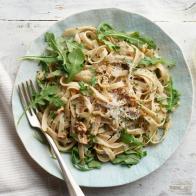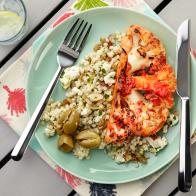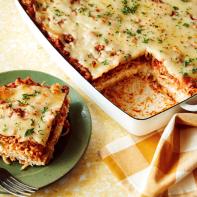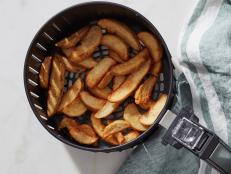Cooking With Cactus, the Life of the Desert
How I grew to love this staple ingredient of Navajo cooking.

Teri Lyn Fisher
Cactus is the life of the desert. For centuries, it’s been a food source for the people and animals that live in the Arizona desert, including members of my tribe, Navajo. When the harvest occurs, it’s tradition for offerings and prayers to be given in respect for what cactus provides our people. The most popular ceremony is the Harvest of the Saguaro Cactus Fruit. It used to be the women who did the harvest, but times changed and now everyone takes part around the beginning of July.
I haven’t always been a fan of cactus, though. As a kid, I fell into a cactus plant in the high Arizona desert, which resulted in a hand full of large thorns and some serious pain. As a teen, on a trip to the supermarket with my grandmother, she told me that the cactus sold there was "not for us." It was "for others to eat." I didn’t understand what she meant, but didn’t ask her at the time to explain.
It wasn’t until I attended culinary school in Phoenix that my relationship with cactus changed. Phoenix and its metro area are located on indigenous land. The Akimel O’odham (Salt River Pima Community) surround the metro area of the city and the indigenous culture is reflected in the architecture and art, and the food. During my time at culinary school, I built relationships with people from tribes in the area and learned how to harvest the pads, fruits and buds of cactus plants.

Teri Lyn Fisher
Cactus pads are the most popular part of the cactus plant and are readily available in markets. Most of the cactus pads you find in the grocery store are cleaned and sometimes jarred. You may see them called nopales. Some people are turned off by cactus pads because, if exposed to the air for a while, the exterior develops a slimy texture. However, this slippery layer is considered the healthiest part of the cactus. Cactus foods are touted for their benefits for blood sugar control, high calcium levels, and boosting the immune system. Use them in a stuffed chicken like the one pictured above.

Teri Lyn Fisher
The cactus fruits like the prickly pear and the saguaro fruit are known for their sweetness and tangy, mild tart flavor. The saguaro fruit is most commonly used to make a syrup, which can be hard to find because very few people know about it. It is best to look at tribal resources to how to acquire it and to know it's purchased from the actual native producers. Prickly pear syrup is also sweet and a bit easier to find online and in grocery stores. The syrup can be used in cocktails like a Prickly Pear Margarita to add sweetness and a beautiful pink color.
Cholla Buds have to be the superior product. Every spring before the flowers bloom, the buds are harvested, then dried and can be stored for years. Cholla buds have been found in ancient ruins of the surrounding area of Phoenix in the Sonoran Desert. The buds have an asparagus, artichoke flavor and can be used whole in dishes or pureed into a sauce — or both, like in this Cholla Bud Pesto Pasta (pictured above).
Years later, I followed up with my grandmother to ask why she said the cactus in the supermarket wasn’t for us. She meant that certain people and tribes live in different regions, and food from one region belongs to the culture that lives in that region. We are taught we can’t simply take a group or culture's way of life unless they want to share it. Food is meant to be shared willingly. Therefore, when I prepare cactus I’m reminded of my fall and painful hand, and how the nopales, cholla and prickly pear have been shared with me by my indigenous Sonoran brothers and sisters.
Freddie J. Bitsoie was born in Utah and grew up in The Four Corners area. He is from the Dine (Navajo) Tribe. Freddie has been studying, preparing and lecturing on Native American foods for over 15 years. He has studied anthropology from The University of New Mexico, Albuquerque and went to culinary school in Scottsdale, AZ. He has contributed to, America, The Cookbook (Phaidon. 2017), been featured in The New York Times, and has been a guest on Lidia Bastianich’s "Lidia Celebrates America." He was also Executive Chef at the National Museum of the American Indian in Washington D.C. Currently, he is quarantining in Phoenix, AZ and working on his first book due out from Abrams Publishing November 2021.

































